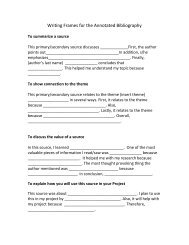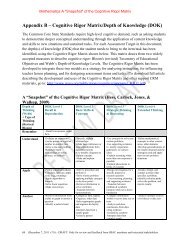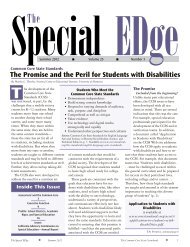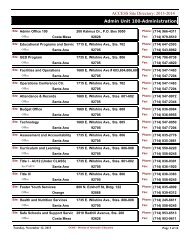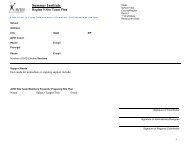Tracheostomy Suctioning
Tracheostomy Suctioning
Tracheostomy Suctioning
Create successful ePaper yourself
Turn your PDF publications into a flip-book with our unique Google optimized e-Paper software.
<strong>Tracheostomy</strong> suctioning<br />
TRACHEOSTOMY SUCTIONING<br />
PHYSICIAN TO SPECIFY: - Check Appropriate Boxes:<br />
Same catheter per<br />
Sterile catheter each<br />
school day [ ] time [ ]<br />
Bulb Syringe[ ] Inner cannula care [ ]<br />
Required<br />
I. PERSONNEL<br />
A. School Nurse<br />
B. Designated school personnel under direct or indirect supervision by the school<br />
nurse.<br />
II. GENERAL INFORMATION<br />
A. Tracheal suctioning is performed to maintain an open airway by keeping it clear<br />
of excessive secretions and to stimulate cough.<br />
B. A qualified person, trained in trach suctioning, must be immediately present &<br />
accompany the student at all times; including transportation and field trips.<br />
C. The student must have easy access to the suctioning equipment at all times.<br />
D. The student should be encouraged to clear airway by coughing and possibly<br />
eliminate the need for suctioning.<br />
E. Unnecessary suctioning should be avoided to reduce chances of tracheal injury<br />
and infection. Increased suctioning may lead to tracheal irritations and/or<br />
increased secretions.<br />
F. <strong>Suctioning</strong> shall be performed:<br />
1. According to physician’s orders which may include removal of inner cannula.<br />
2. Upon request of child.<br />
3. When noisy, moist respirations occur.<br />
4. When respiratory distress exists (restlessness, crying, anxious look, pale or<br />
dusky color, chest retractions, nasal flaring and/ or labored breathing).<br />
5. When mucous is visible at trachea opening and student is unable to clear it<br />
with cough.<br />
Revised 4/2006- AAP approval pending<br />
1
<strong>Tracheostomy</strong> suctioning<br />
III.<br />
TRACHEOSTOMY SUCTIONING<br />
Student’s Name:_________________________________ DOB:___________________<br />
Equipment<br />
and Supplies<br />
*(Responsibility<br />
of parent/care<br />
provider)<br />
1. *Suction machine including<br />
collecting bottle, connecting tube<br />
and adapter when needed.<br />
2. *Resuscitation bag when ordered<br />
(such as Ambu bag).<br />
3. *Sterile disposable suction<br />
catheters and/or bulb syringe if<br />
indicated.<br />
4. *Extra sterile tracheostomy<br />
replacement kit.<br />
5. *Non-waxed clean paper cups.<br />
ESSENTIAL STEPS<br />
PROCEDURE<br />
1. Verify that the tracheostomy tube is in<br />
place and secure.<br />
2. Verify at the beginning of each school day<br />
that all equipment/supplies are ready for<br />
immediate use and document on the<br />
checklist.<br />
3. Turn suction machine on and place thumb<br />
over end of connecting tubing (ensure that<br />
connecting tube is in place).<br />
a. Assure that suction bottle is clean and<br />
empty.<br />
4. Determine need for suction.<br />
5. Explain procedure to the child at<br />
appropriate level of understanding.<br />
6. *Supply of sterile normal saline (or<br />
single dose vials).<br />
7. *Supply of water.<br />
8. *Sterile syringes for introducing saline<br />
into trachea.<br />
9. Clean tissues or gauze pads.<br />
10. Plastic lined wastebasket (kept beside<br />
machine and used for contaminated<br />
materials).<br />
11. Personal protective equipment (face<br />
& eye protection, apron, gloves, etc.)<br />
KEY POINTS & PRECAUTIONS<br />
Bus aide must verify prior to transporting student<br />
to school.<br />
For bus transportation: if equipment is not<br />
functioning, then student will not be permitted to<br />
attend school.<br />
Note: For machines with adjustable manometers<br />
ensure that pressures are appropriate as follows:<br />
Infant (less than 2 years): 50-95 mm Hg<br />
Child (2-8 years): 95-100mm Hg<br />
Adult (8 & above): greater than 115 mm Hg<br />
Revised 4/2006- AAP approval pending<br />
2
<strong>Tracheostomy</strong> suctioning<br />
ESSENTIAL STEPS<br />
KEY POINTS & PRECAUTIONS<br />
6. Position student. Positioning is dependent upon student’s condition a<br />
physician’s recommendations. Consider<br />
positioning student in a location that can easily<br />
be disinfected.<br />
7. Wash hands.<br />
8. Assemble and prepare equipment on a Clean field can be established by using a clean<br />
clean field<br />
covering (disposable towel, paper towel,<br />
a. Fill paper cup with water.<br />
waterproof pad, etc.) over any cart, tabletop,<br />
b. Open catheter package and while countertop, wheelchair tray, stool, etc.<br />
leaving catheter in its wrapper, attach Catheter is left in wrapper to prevent<br />
connecting end to suction tubing and contamination.<br />
turn suction machine on.<br />
May use bulb syringe if indicated (refer to Bulb<br />
c. Open saline vial.<br />
Syringe in Oral Nasal <strong>Suctioning</strong>).<br />
d. Place tissues nearby.<br />
If inner cannula is used, leave in place unless<br />
directed otherwise by physician. If removed,<br />
refer to Care and Cleaning of Inner Cannula.<br />
9. Glove. Gloves are used to keep catheter and hands clean.<br />
10. Place catheter tip in cup of water and This ensures that adequate suction is present.<br />
suction a small amount of water through it.<br />
11. Suction as follows:<br />
a. Leaving the vent open, introduce the<br />
catheter into the trach tube a distance<br />
no longer than that tube.<br />
b. Place thumb over vent to apply suction.<br />
With other hand, gently rotate catheter<br />
between thumb and forefinger while<br />
slowly withdrawing catheter.<br />
c. Suction no longer than 10 seconds at a<br />
time. Allow adequate recovery time<br />
before re-introducing catheter.<br />
d. Repeat suctioning as needed.<br />
ESSENTIAL STEPS<br />
The distance for catheter insertion should be<br />
determined during initial training of staff.<br />
Length of trach tube can be approximated by<br />
measuring replacement trach tube.<br />
<strong>Suctioning</strong> past the trach tube may cause coughing,<br />
tracheal irritation, and/or blood-tinged<br />
secretions.<br />
If student begins to cough, withdraw catheter while<br />
suctioning.<br />
IMPORTANT: If you are unable to pass catheter<br />
through trach tube, it may be obstructed. If signs<br />
of respiratory distress occur (labored breathing,<br />
apnea, pallor and/or cyanosis), the trach tube<br />
should be changed. Refer to<br />
TRACHEOSTOMY REPLACEMENT<br />
PROCEDURE.<br />
Prolonged suctioning can cause throat spasm, loss<br />
of oxygen and changes in heartbeat.<br />
If secretions are thick, instill 3 to 5 drops of saline<br />
into trach tube opening then repeat suctioning.<br />
Saline aids in loosening mucous. This will cause<br />
coughing, therefore, hold tissue near trachea to<br />
catch spray and/or mucous to prevent<br />
contamination of surroundings.<br />
Respirations should be quiet and effortless at end of<br />
suctioning.<br />
KEY POINTS & PRECAUTIONS<br />
Revised 4/2006- AAP approval pending<br />
3
<strong>Tracheostomy</strong> suctioning<br />
12. Suction sufficient water through catheter<br />
to clear out tubing.<br />
13. If catheter can be used again (per<br />
physician order), replace catheter in<br />
package.<br />
14. If catheter cannot be used again, hold<br />
catheter in gloved hand, pull glove off,<br />
encase catheter in glove and discard both.<br />
15. Discard paper cup.<br />
16. Wash hands.<br />
17. Recap water and make sure equipment is<br />
ready for immediate reuse.<br />
18. At the end of the school day, glove and<br />
empty contents of suction bottle into<br />
toilet and rinse with water.<br />
19. Close plastic liner of wastebasket<br />
securely prior to disposal.<br />
20. Record procedure on SPHCS log.<br />
Cleaning and disinfecting the suction<br />
canister is a parent/careprovider responsibility.<br />
However, if the suction machine is school property<br />
and remains at school then it must be cleaned<br />
according to manufacturer’s instructions.<br />
Revised 4/2006- AAP approval pending<br />
4




